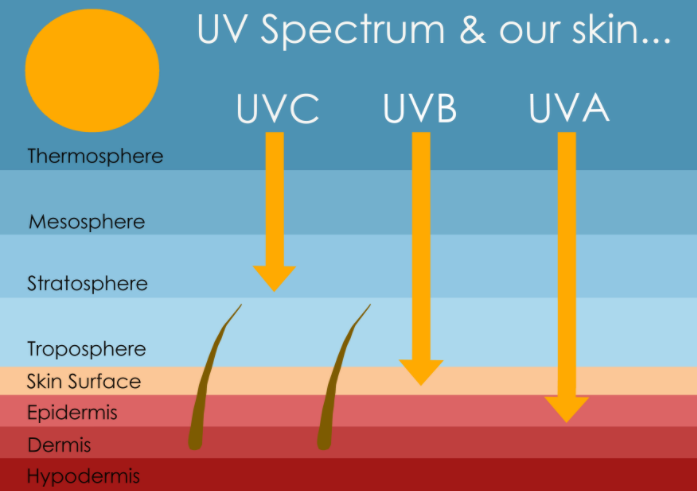Benefits of the Sun
The sun gets a bad rap, although without it, there would be no life on the planet. Obviously, there is a disconnect there. Like all things in life, the right balance is the recommendation. As you will see, the benefits way outperform the risks.
Most people are familiar with the synthesis of vitamin D from the sun. This is important for bone health, prevents rickets, and can aid in immune defense against viruses. A point of interest is that the darker your skin is, the more time you may have to spend in the sun to make adequate vitamin D. Credit to Dr. Ben Bikman on this one; he theorizes that this may be one of many variables why we see coronavirus affecting people of color at greater rates. Check out the Melanie Avalon podcast where he talks about this.
Vitamin D deficiency is implicated in a whole host of autoimmune diseases such as rheumatoid arthritis and multiple sclerosis. In fact a comprehensive review by Sintzel et. al (2017) demonstrated a 41% decrease in multiple sclerosis with adequate vitamin D levels. This explains why incidence rates of multiple sclerosis is much higher in northern climates. Additionally, activated vitamin D has been shown to interfere with the growth factors for tumor cells (Chakraborti, 2011).
Sunlight increases production of serotonin, a neurotransmitter of the brain. Serotonin has been shown to reduce pain perception in individuals with fibromyalgia (Paredes et. al, 2019). Lack of sun has been shown in various studies to be the primary variable in seasonal affective disorder (S.A.D.).
Sunlight can help sleep as well. Circadian rhythms modulate our sleep/wake cycles. Melatonin is secreted by the brain after the sun sets which makes you sleepy. Adequate sunlight improves the amount of melatonin you produce. Particularly the blue light waves which penetrate deeper. Quick physics lesson: the shorter the wavelength, the shorter the distance it can travel and it penetrates less. The longer the wavelength, the further it travels. This is why the ocean is blue, and in fact when you go scuba diving, if you’re down more than 40 meters, basically everything looks blue until you shine a flashlight on it. (Pro tip: scuba dive at shallower depths; you have more time, more color, and it’s safer). The same is true of soundwaves, and that’s why you only hear the booming bass of that obnoxious car next to you.
Another substance created by the sun is nitric oxide, a vasodilator (relaxes blood vessels). Nitric oxide has benefits such as inflammation reduction, wound healing, and antimicrobial effects. It also has a dramatic effect on blood pressure. There is an inverse correlation to latitude and blood pressure. In other words, the closer you live to the equator, the lower your blood pressure is (Duraton et. al, 2018), because the blood vessels dilate. Nitric oxide also has an effect on blood sugar. In the winter, average Hb A1c (measure of blood glucose) increases, and lowers in the summer (Mead, 2008).
So how do we get more of the benefits of sunlight? After all, vitamin D deficiency is at epidemic proportions, and you’d have to drink 6 glasses of milk a day to get an adequate dose. It’s all about sensible sun exposure, and if that isn’t possible, then you may want to consider supplementation. Obviously your skin tone will play a major role in how much you can tolerate, but you should aim to never get a sunburn.
So time for another quick physics lesson. The ultraviolet (UV) radiation from the sun is broken into three parts: UVA, UVB, and UVC. Earth is enveloped by an atmosphere that protects us from radiation to a degree. UVC is unable to penetrate the atmosphere, so we’ll ignore that one. UVA can make it all the way to the ground, and UVB can make it to the ground when the sun is directly overhead. When the sun is at an angle, the UVB rays don’t make it to us. All of the harmful, DNA damaging rays come from UVB. So in other words, the mornings and afternoons are safe. A good rule of thumb to live by is that if your shadow is as tall as you, you don’t need sunscreen. If your shadow is small like it is at noon, use protection.
References:
Chakraborti, C. (2011). Vitamin d as a promising anticancer agent. Indian Journal of Pharmacology, 43(2), 113. doi:10.4103/0253-7613.77335
Duranton, F., Kramer, A., Szwarc, I., Bieber, B., Gayrard, N., Jover, B., . . . Argilés, À. (2018). Geographical variations in blood pressure level and seasonality in hemodialysis patients. Hypertension, 71(2), 289-296. doi:10.1161/hypertensionaha.117.10274
Paredes, S., Cantillo, S., Candido, K. D., & Knezevic, N. N. (2019). An Association of SEROTONIN with PAIN disorders and Its MODULATION BY ESTROGENS. International Journal of Molecular Sciences, 20(22), 5729. doi:10.3390/ijms20225729
Sintzel, M. B., Rametta, M., & Reder, A. T. (2017). Vitamin d and multiple sclerosis: A comprehensive review. Neurology and Therapy, 7(1), 59-85. doi:10.1007/s40120-017-0086-4
Other Resources:


